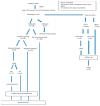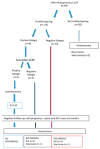The Coexistence of Cervical Intraepithelial Neoplasia (CIN3) and Adenocarcinoma In Situ (AIS) in LEEP Excisions Performed for CIN3
- PMID: 38473209
- PMCID: PMC10931211
- DOI: 10.3390/cancers16050847
The Coexistence of Cervical Intraepithelial Neoplasia (CIN3) and Adenocarcinoma In Situ (AIS) in LEEP Excisions Performed for CIN3
Abstract
The purpose of this study was to evaluate the incidence of AIS and AC in the histological cone of women treated for CIN3. Furthermore, through the study of the specific HR HPV genotypes, we obtained more information on the possible different nature between the single CIN3 lesion and the CIN3 coexisting with the glandular lesion.
Methods: A sample of 414 women underwent LEEP for CIN3. The study sample consisted of 370 women with a CIN3 lesion alone and 44 women with a CIN3 lesion coexisting with AIS or adenocarcinoma. We studied the individual HR HPV genotypes and their frequency in the two groups under study. Furthermore, the therapeutic results and follow-ups for the population were studied on the entire study sample.
Results: In patients with a single CIN3 lesion, 11 high-risk genotypes were detected; in patients with CIN3 associated with AIS or AC, only 4 different genotypes were detected (16, 18, 45, 33). Overall, the frequency of HPV 18 was significantly higher in CIN3 coexisting with AIS compared to solitary CIN3 lesions, χ2 = 27.73 (p < 0.001), while the frequency of other high-risk genotypes was significantly higher in patients with a single CIN3 than in patients with CIN3 coexisting with AIS. In our study population, mixed lesions (CIN3 coexisting with AIS), unlike their squamous counterparts (single CIN3 lesions), were characterized by skip lesions, which demonstrate more aggressive behavior and a higher rate of viral persistence and recurrence.
Conclusion: A relatively high rate (10.7%) of AIS-AC was found in women treated for CIN3. Our study confirms the multifocal biological nature of the CIN3 lesion coexisting with AIS compared to the single CIN3 lesion. All this justifies the different treatments to which CIN3 lesions coexisting with AIS are addressed; in fact, the latter are treated with hysterectomy, while CIN3 is treated with conization alone.
Keywords: coexistent CIN3-AIS; fertility sparing; specific genotyping; trachelectomy.
Conflict of interest statement
The authors declare no conflicts of interest.
Figures



References
-
- Holl K., Nowakowski A.M., Powell N., McCluggage W.G., Pirog E.C., Collas De Souza S., Tjalma W.A., Rosenlund M., Fiander A., Jenkins D., et al. Human papillomavirus prevalence and type-distribution in cervical glandular neoplasias: Results from a European multinational epidemiological study. Int. J. Cancer. 2015;137:2858–2868. doi: 10.1002/ijc.29651. - DOI - PMC - PubMed
-
- Ciavattini A., Giannella L., De Vincenzo R., Di Giuseppe J., Papiccio M., Lukic A., Delli Carpini G., Perino A., Frega A., Sopracordevole F., et al. HPV Vaccination: The Position Paper of the Italian Society of Colposcopy and Cervico-Vaginal Pathology (SICPCV) Vaccines. 2020;8:354. doi: 10.3390/vaccines8030354. - DOI - PMC - PubMed
LinkOut - more resources
Full Text Sources

